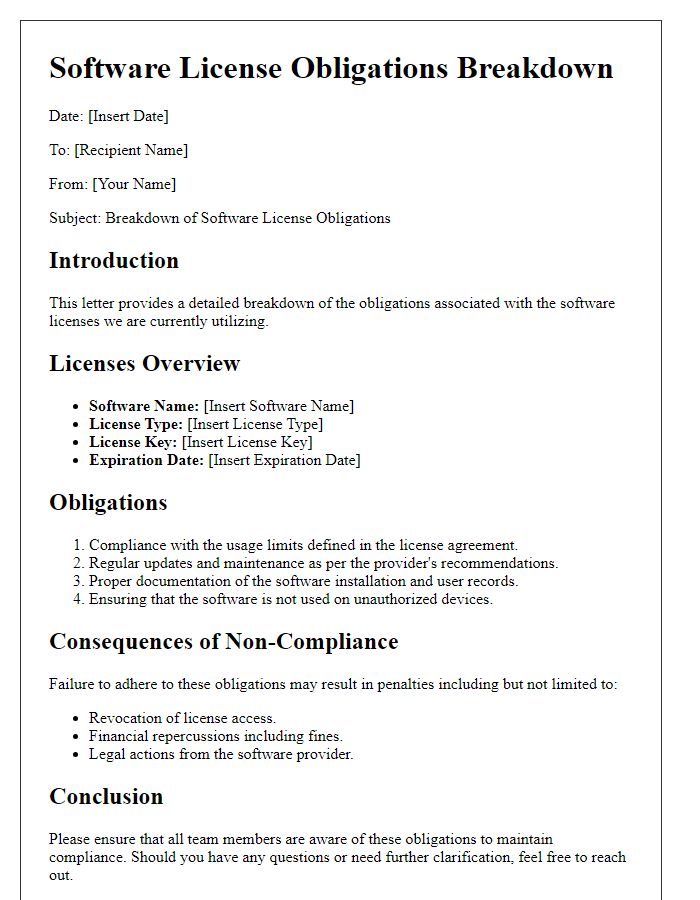Are you curious about the ins and outs of software licensing and what it means for your business? Understanding software licensing terms can seem daunting, but it's essential for safeguarding your intellectual property while maximizing software usage. In this article, we'll break down the key elements of software licensing agreements and explain how they can impact your organization's operations and compliance. So, let's dive in and explore these important concepts together!

Clear Definition of Software License Types
Software licenses delineate specific usage rights and restrictions for applications, systematically categorizing them into various types. Proprietary licenses grant exclusive rights to the publisher, often restricting modifications or redistribution, commonly seen in well-known applications like Microsoft Office. Open-source licenses, like the GNU General Public License (GPL), allow users to access, modify, and distribute the software, fostering community collaboration and innovation. Freeware licenses enable users to utilize the software at no cost but usually prohibit changes or resale, exemplified by Adobe Acrobat Reader. Shareware licenses provide a trial period during which users can evaluate the software before purchasing the full version, typically observed in applications like WinZip. Each license type serves distinct purposes, catering to developers and consumers within the software ecosystem.
Usage Rights and Restrictions
Usage rights in software licensing agreements define the legal permissions granted to users regarding the use of software applications, often including stipulations on the number of devices such as personal computers, smartphones, or tablets permitted to run the software. Restrictions may outline prohibitions against actions such as reverse engineering, copying, or distributing the software, ensuring intellectual property protection, which might include proprietary algorithms or source code. Licensing agreements often specify license duration, detailing time frames for use that could range from monthly subscriptions to perpetual licenses, often influenced by software types like cloud-based applications versus traditional installed software. Violations can lead to consequences, including termination of rights and potential legal action, emphasizing the importance of understanding and adhering to the agreed terms within various business environments.
Compliance and Audit Clauses
Software licensing agreements often include compliance and audit clauses that ensure adherence to the terms set forth. Compliance clauses stipulate that users must utilize the licensed software according to specified regulations and licensing terms, which may cover usage limits, installation on designated hardware, or geographic restrictions. Audit clauses grant the software vendor the right to conduct periodic checks, typically annually, to verify compliance with licensing terms. These audits may involve reviewing installation records and usage statistics, assessing whether the software is deployed within the agreed parameters. Failure to comply with these clauses can result in financial penalties, including back payments for unlicensed use, highlighting the importance of maintaining accurate records and ensuring all installations adhere to the licensing agreement.
Renewal and Termination Conditions
Renewal and termination conditions are critical elements of software licensing agreements. Typically, the renewal process involves a predefined period, which may range from one year to three years, wherein the license remains valid. Licensees often receive notifications approximately 30 to 60 days prior to expiration, allowing adequate time for review. Automatic renewal clauses may bind the licensee unless a written notice of intent to cancel is provided. Termination conditions, on the other hand, detail circumstances under which either party may dissolve the agreement. Common reasons for termination include substantial breach of contract, insolvency, or failure to comply with licensing restrictions. Specific conditions may include a grace period for remedy actions, usually spanning 15 to 30 days, highlighting the need for clear communication in maintaining operational integrity.
Support and Maintenance Agreement
The Support and Maintenance Agreement provides essential services for software operations, ensuring optimal performance and reliability for end-users. This agreement details the scope of support, which includes regular updates (monthly patches), bug fixes (critical vulnerabilities), and technical assistance (24/7 helpdesk access). Clients receive enhanced service levels (e.g., response times of less than 4 hours for urgent issues) tailored to their needs, including remote and on-site support options (available in over 100 countries). This contract also outlines the terms for software upgrades (major version releases) and the requirement for periodic reviews (scheduled annually) to assess service effectiveness. Moreover, it emphasizes user compliance with licensing terms (adhering to the number of installations as specified in the agreement), ensuring that intellectual property rights are respected and protected.













Comments